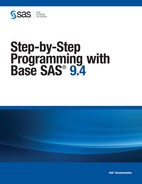Summary
Statements
IF condition THEN action;
<ELSE action>;
tests whether condition is
true. If the condition is true, the action in the THEN clause is carried
out. If condition is false
and an ELSE statement is present, then the ELSE action is carried
out. If condition is false
and no ELSE statement is present, then the next statement in the DATA
step is processed. Condition specifies
one or more numeric or character comparisons. action must
be an executable statement. That is, one that can be processed in
an individual iteration of the DATA step. (Statements that affect
the entire DATA step, such as LENGTH, are not executable.)
Functions
INDEX(source, excerpt)
searches source for
the string given in excerpt.
Both source and excerpt can
be any type of character expressions, such as character variables,
character strings that are enclosed in quotation marks, other character
functions, and so on. When excerpt is
present in source, the function
returns the position of the first character of excerpt (a
positive number). When excerpt is
not present, the function returns a 0.
..................Content has been hidden....................
You can't read the all page of ebook, please click here login for view all page.
